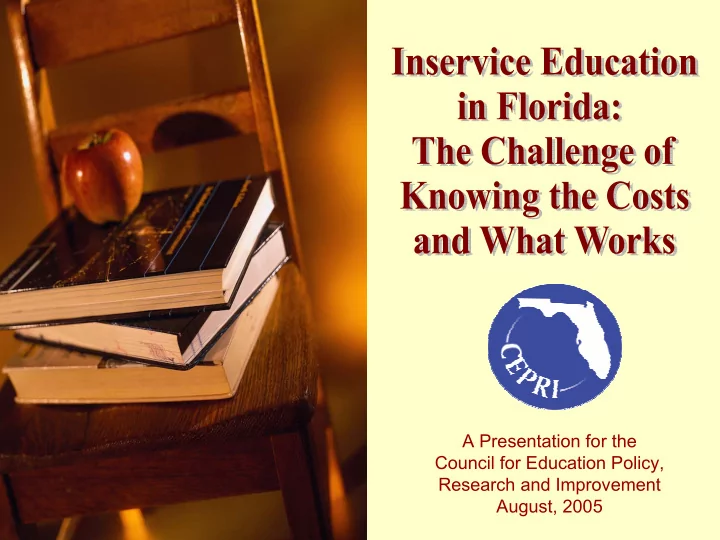

A Presentation for the Council for Education Policy, Research and Improvement August, 2005
What We Know About Inservice • Florida statute 1012.585 (See Appendix) requires all teachers to renew their certificates every five (5) years through the accrual of either six (6) semester hours of college credit of 120 hours of inservice • Research on teacher performance and student achievement indicates that professional development can assist district achieve goals related to these educational goals • The federal No Child Left Behind Act requires states to show an annual increase in the percentage of teachers participating in “high quality” professional development
Inservice Participation Rates and Activities Ins ervice Participation Over a 12-Month Period 95 100 90 Percent of Teachers 74 80 70 60 47 42 50 34 32 40 25 23 22 30 20 10 0 s h s s s g g ) ) e c n n n r n n t c e r i o o o i d a i n h h k i i i e e e c t c t t r s a a a a r a o r e C e c e v t o w R n f T r f C n e i o e t t e s s / p o r N / w e b e g N C u c r n O ( o P n e / s i r s r R e o r G e p l e o o h s i ( c o t t / o c a r n h n s l a u a h r e e e s e o u o c s r k M S T C e b d r r u a f o i / v s n . l o W s l i v o C l d a o i C n n l C C . U I v i n U Source: National Center for Educational Statistics (2003)
The Challenges of Knowing • Knowing the costs and “what works” in professional development is complicated due to a number of factors: • Fragmentation of the training process (often involving schools, districts, higher education, states, federal government, teachers unions, and other educational organizations • Lack of definition and data on “effective professional development activities” (activities may include workshops, conferences, peer collaboration, class/school observations, study groups, etc.) • Difficult to determine a causal relationship between professional development and student achievement (because it is only one of a myriad of intervening variables including socio- economic status, race, school contexts, etc.) • Lack of uniform definition of spending categories and inadequate data collection present a challenge for cost accounting (staff development funds are imbedded in nearly every category of school funding, including state and federal dollars, private grants, and teachers paying for courses without seeking reimbursement)
Florida’s Efforts to Meet the Challenges • The Florida legislature enacted F.S. 1012.98 , the School and Community Professional Development Act , to meet the NCLB mandate of “ showing an annual increase in the percentage of teachers participating in “high quality” professional development ” • Inservice evaluation processes were created through the Florida Professional Development Protocols (including on-site audits by state and district school personnel)
NCLB & Professional Development • NCLB defines high quality training activities as, “sustained, intensive, and classroom- focused in order to have a positive and lasting impact on classroom instruction and the teacher’s performance in the classroom; not one- day, short term workshops or conferences”
Where’s the Money? • State categorical funding for inservice totaled $36 million in recent years, but was cut to $18 million for 2005-06 • Other state funding from general revenue accounts, plus federal dollars raises the funds available for inservice to over $181 million • Currently, the state does not track inservice expenditures in a manner to create a comprehensive picture of the training activities in the state
Tracking Down the Dollar$ • The six core elements of professional development costs are: • Teacher Time • Training and Coaching • Program Administration • Materials, Equipment, and Facilities • Travel and Transportation • Tuition and Conference Fees
Phase II Study Proposal • Conduct a quantitative and qualitative analysis of in-service education funding allocations, policies and procedures in a representative sample of Florida school districts . Review state-level accounting reports and school district expenditure analysis reports in order to gain an accurate accounting of district expenditures from all sources for professional development. • Review the findings of the first cycle of on-site reviews of selected school districts using the Professional Development System Evaluation Protocols and gather data on the evidence of improved student performance based on staff development participation/practices. • Identify “best practices” in school district professional development programs that are targeting increased student achievement, particularly in low-performing districts and schools. • Work with the Schultz Center and Duval County School District to develop a model for measuring the effectiveness of staff development in terms of improved student achievement .
Phase II Study Timeline • August: Present Phase II Proposal to Council members • Aug.-Oct.: Survey Schultz Center staff and other inservice administrators to conduct cost analysis and determine “best practices” • October: Provide study update to Council members • November: Present draft of final report to Council members • December: Present final report to Council members
Recommend
More recommend